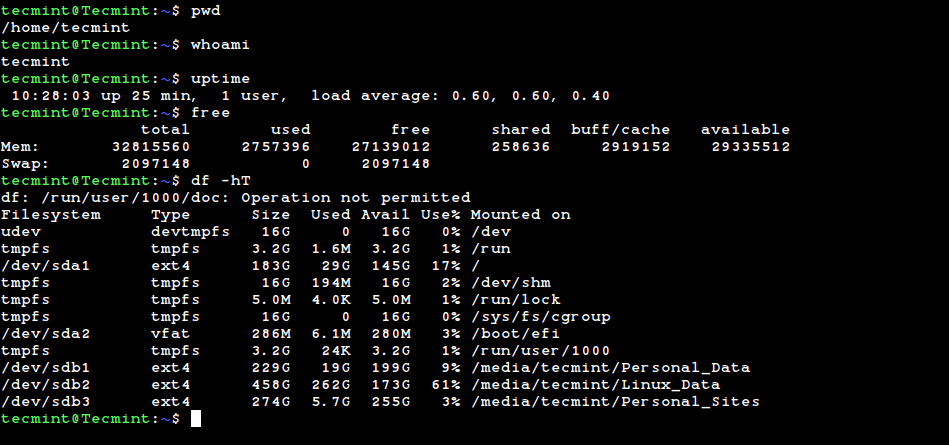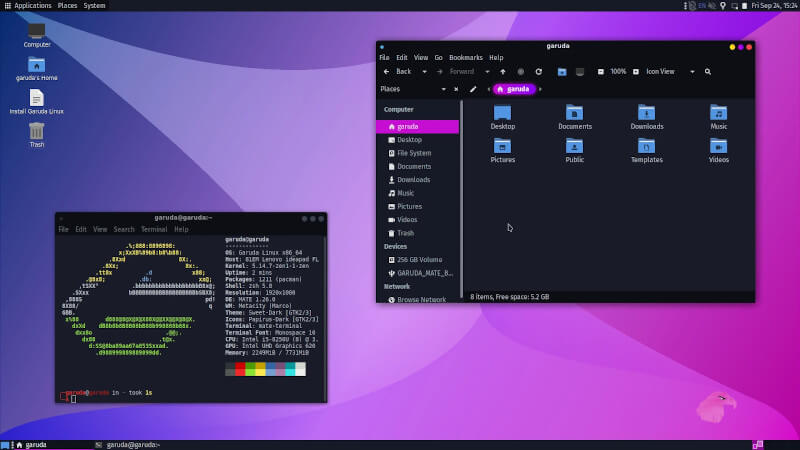
Posted on 02/02/2023 2:58:36 PM PST by ShadowAce
Linux is an open-source, community-developed operating system with the kernel at its core, alongside other tools, applications, and services.
Like any other operating system like Windows or MAC, it manages the hardware resources of a system such as CPU, RAM, and storage. The kernel interfaces the operating system and the underlying hardware and facilitates communication between the two.
A command line is an interface that allows you to type and run Linux commands which instruct the operating system on what actions to carry out. A command-line interface is provided by a terminal or terminal emulator such as GNOME Terminal, Konsole, and XTERM.
Working on the command line is the ideal way of administering a Linux system, especially when working with a headless server or a minimal system (A Linux system that does not provide a GUI).

Linux Command Line Interface
At the core of every Linux system is the kernel. The kernel is what sets apart Linux from other operating systems. It is the central component of the operating system and acts as a bridge between the user-level applications and the underlying hardware components.
It enables the communication between the software and the underlying physical hardware. The kernel manages all the running processes, memory, files, and so on. In a nutshell, the kernel takes care of the following:
As mentioned before, the kernel sits right in the middle of User processes and the underlying hardware which comprises RAM, CPU, I/O devices, storage, graphics, and networking.
Apart from the kernel, the Linux Operating system includes other essential components such as GNU tools, system utilities, installed applications, and many others. All of these bundled together constitute a functional operating system.
A desktop environment is a collection of components that provide a Graphical User Interface (GUI) that allows users to seamlessly interact with the operating system. It comprises graphical elements such as icons, menus, windows, taskbars, wallpapers, widgets, and panels to mention a few.
A desktop environment is provided, by default, in modern graphical Linux distributions such as Debian, Ubuntu, Fedora, Rocky, and AlmaLinux. It enhanced user interaction and enables users to easily manage the system as opposed to the command line interface which requires a high skill set to use.
Examples of popular desktop environments include GNOME, Cinnamon, KDE Plasma, MATE, Deepin, XFCE, LXDE, and LXQt.

Linux Desktop Environment
Linux is a free and open-source operating system that was initially released to the general public in 1991. It is currently under the GNU General Public License (GPL). Opensource implies that anyone can study, modify and redistribute the source code, provided they do so under the GNU GPL license terms.
Over time, Linux has grown in leaps and bounds to become one of the biggest open-source projects in the world. It has won the hearts of IT professionals, desktop lovers, and hobbyists from all over the globe.
It enjoys a wide community of vibrant and indefatigable developers who contribute to the kernel, search and fix bugs, add new features and brainstorm new ideas while sharing their views and opinions with the community.
Often abbreviated as ‘distro’ a Linux distribution is a version of the Linux operating system that is based on the Linux kernel. It ships with other components such as system tools and services, applications, and additional programs such as LibreOffice, GIMP, and Firefox web browser.
Popular free Linux distributions include Ubuntu from Canonical, Debian from the Debian Project, Fedora from the Fedora Project, OpenSUSE from SUSE, and Rocky and AlmaLinux both of which are 100% binary compatible with Red Hat.
Commercial distributions include Oracle Linux, Red Hat Enterprise Linux (RHEL), and SUSE Enterprise Server (SLES).
There are tons of Linux distributions and choosing the right one usually boils down to what you want to accomplish with it. Before opting for your distribution of choice, it’s worth taking time to familiarize yourself with the differences and nuances that exist between various Linux distributions.
At a glance, Linux distributions differ in the following ways.
With that in mind, choosing the right distribution is mostly a personal thing and depends on what your goal is. So here is a breakdown of Linux distributions suited for particular use cases:
When it comes to choosing a beginner-friendly Linux distro for learners or beginners in Linux, Ubuntu leads the pack. It’s a completely free and open-source distribution that provides an intuitive and user-friendly user interface that offers a seamless user experience.
Out of the box, you also get essential applications needed to get off the ground such as LibreOffice suite, Firefox browser, audio & video player, photo viewer, screenshot tool, thunderbird email client, calendar, and many more. It’s highly customizable and versatile.
Other beginner-friendly distributions include Linux Mint, Zorin, Elementary OS, MX Linux, and Linux Lite. It’s worth noting that most of these are based either on Debian or Ubuntu.
For intermediate to advanced users such as developers and system engineers and administrators, Debian, SUSE Linux, RHEL, Rocky, AlmaLinux, and Fedora are recommended.
These are excellent all-rounders that can serve both as desktop distributions and also in enterprise setups handling production workloads.
Linux distributions optimized for server environments, including bare-metal and cloud deployments include RHEL, SUSE Linux Enterprise Server (SLES), Debian stable, Ubuntu Server, and Fedora (Fedora Server and Fedora CoreOS for containerized workloads.
They are considered ideal due to their high performance, impressive stability, and security.
For artists, content creators, and producers of multimedia content, Ubuntu Studio and Fedora Design Suite come in handy.
Kali Linux, Black Arch, and Parrot OS are Linux distributions considered ideal for security-related tasks such as penetration testing, and digital forensics.
This was a brief introduction to Linux. We have covered essential sub-topics such as various desktop environments, desktop environments, and tips on how you can go about choosing the right Linux distribution for your day-to-day tasks.
Whether you are a beginner or a seasoned system administrator or engineer, there’s a Linux distribution for everyone.
BKMRK.
Android is Linux.
The idea that a Linux distro could never go mainstream is not true. It just has to be marketed correctly.
Thank you my friend!
“The idea that a Linux distro could never go mainstream is not true. It just has to be marketed correctly.”
Almost every website server out there is Linux. All the super computers and CERN are Linux. Whole countries run Linux as their government data system. Smart appliances all run Linux.
MS is nothing anymore compared to what runs Linux. Except desktops because people are lazy. Just too lazy to try it.
How does Linux work. So far over the last year, flawlessly.
It takes about 2 weeks to make the transition. Nothing windows does can’t be done on Linux.
XP Theme for Cinnamon.

https://cinnamon-spices.linuxmint.com/themes/view/Mint-XP
“How does Linux work. So far over the last year, flawlessly.”
Isn’t that great? Updates do not break it and it needs very little if any maintenance. It is just solid, stable, and works.
I am six years in now... :)
:format(webp)/cdn.vox-cdn.com/uploads/chorus_image/image/53092035/welcome_to_the_jc27bb.0.jpg)
Everything is misspelled...
No.


Anxious about command line, as I have ADD and osteoarthritis = don’t care to type much or remember stuff with precision. Suggestions?
That has not been my experience.
1. I do a great deal of work in PowerPoint that is published via Acrobat. The Linux pdf publishing and editing software is not equivalent. I haven't got into it but I don't think it even allows me to manage links in pdf.
2. The pdf software in Linux I have used so far does not do OCR, which I need for research purposes. A lot of important old books are just scans.
3. Photoshop is not functional on Linux. Please don't tell me that GIMP is equivalent; its RAW editor isn't even close. 4. I have a 13GB outlook.pst file that has been a total pain to convert to mbox for Thunderbird on Win10, even with well regarded third party software. I won't even attempt to move the Win10 Thunderbird data to a Linux Thunderbird until it works. I absolutely must have that monster email history to function.
If anyone here has solved these problems before, I need help. Please respond by FReepmail.
Disclaimer: Opinions posted on Free Republic are those of the individual posters and do not necessarily represent the opinion of Free Republic or its management. All materials posted herein are protected by copyright law and the exemption for fair use of copyrighted works.